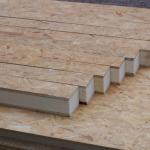What ceiling is better to make in the kitchen?
Hi all! When choosing finishing materials for the ceiling in the kitchen, it is important to pay attention to such an aspect as practicality, especially if there is no hood installed in the room and soot and tiny particles of fat settle on the ceiling. The surface should be easy to clean, not be afraid of moisture and high temperatures. Next, we compare the popular finishes for kitchen ceilings.
Plastering and painting
Applying a plaster layer is used if necessary to level the surface. The use of this classic material has the following advantages:
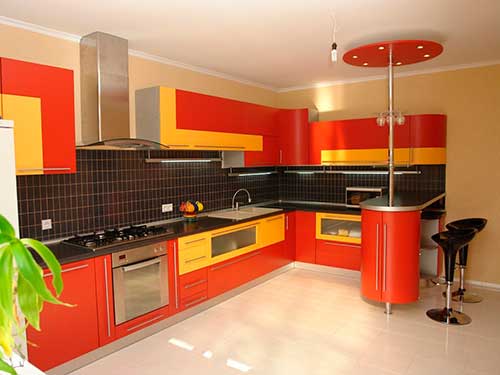
- allows you to eliminate any unevenness of the overlap;
- guarantees environmental cleanliness of the finish;
- forms a "breathing" surface, which has a beneficial effect on the microclimate;
- practically does not "eat" the height of the ceilings.
However, plastering also has a serious drawback - the high labor intensity and complexity of the work.
So that the plastered ceiling can be cleaned of dirt, it is painted with a water-based emulsion suitable for repeated washing. An even more practical option is the use of facade paint.
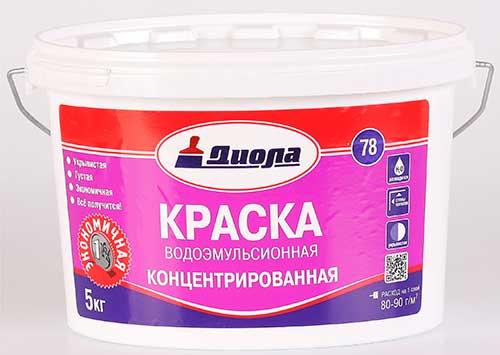
You can use decorative moisture-resistant plaster and treat the surface of the ceiling with a composition that creates a strong moisture-resistant and wear-resistant film on the surface.
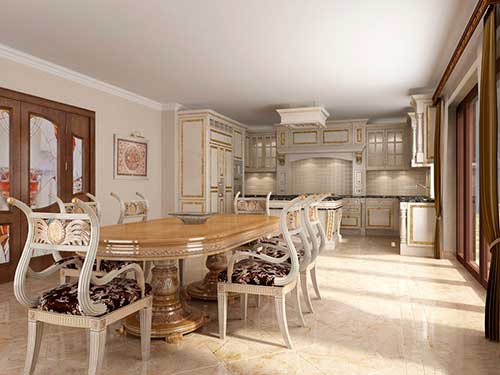
When flooded from above, the plaster layer can be seriously damaged, which will require repair.
Plasterboard constructions
GKL sheets are used for leveling the ceiling without "wet" processes, as well as for the construction of spectacular multi-level structures, if the height of the room allows it. The advantages of using drywall also include the ability to perform hidden laying of communications and mount spotlights.
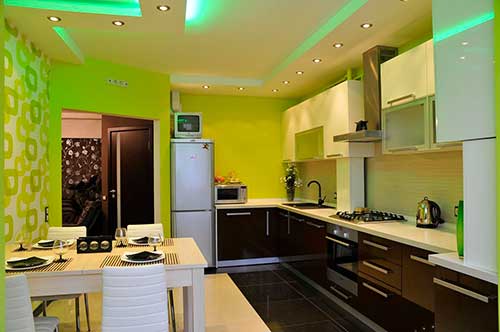
In the kitchen, it is important to use moisture-resistant GKL. For finishing the structure, preference should be given to wear-resistant coatings that are not afraid of moisture - facade paint, washable wallpaper, moisture-resistant decorative plaster.
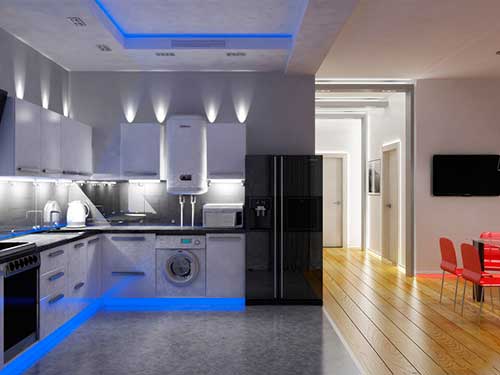
When flooded from above, drywall may warp and the structure will have to be redone.
Styrofoam tiles
Expanded polystyrene decorative tiles have gained popularity due to their low cost and ease of installation. It is suitable for finishing wet rooms, because it is not afraid of water and steam. The elasticity of the tiles allows you to hide small irregularities in the ceiling tiles.
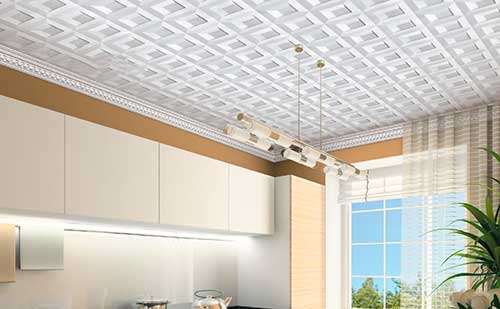
Such material is not suitable for a kitchen ceiling, since it is quite difficult to fully clean the surface of polystyrene boards from soot and grease - over time, the ceiling loses its attractive appearance. But as a temporary option in anticipation of a major overhaul, this type of finish has the right to life.
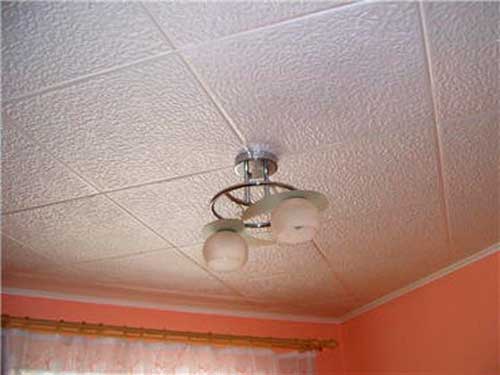
When flooded from above, the ceiling finish will not suffer if it is glued with a moisture-resistant compound to a solid base.
Plastic lining
Plastic panels for finishing the ceiling are very popular, thanks to:
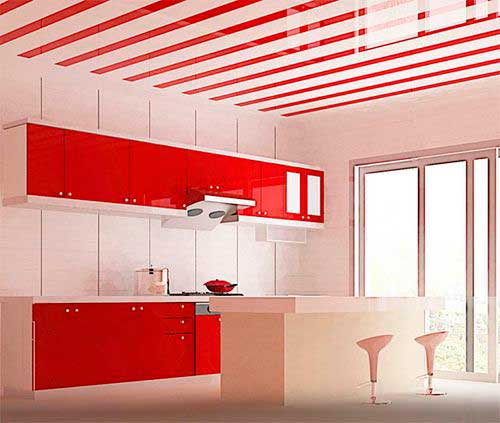
- aesthetic appearance;
- wear resistance and resistance to moisture;
- relatively simple installation;
- the ability to hide defects in the ceiling;
- increase the sound insulation of the ceiling;
- the ability to lay communications and install spotlights;
- maintainability (in case of accidental damage to the finish, it is enough to replace only the affected elements without dismantling the entire coating);
- ease of care (the surface is easily cleaned of dirt with conventional detergents).
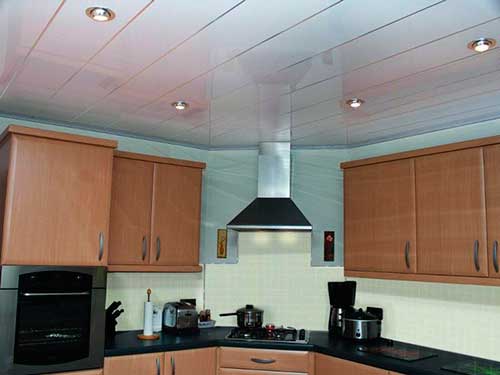
With all the positive qualities of the material, it is worth considering the use of PVC lining in the kitchen, because:
- installation of the crate is required, which will reduce the height of the ceiling by 5-10 cm;
- panels are not resistant to fire and propagate combustion with the release of toxic substances.
When flooded from above, the finish will not suffer, while it will not retain water.
metal panels
Ceiling panels are mainly made of aluminium. Ceiling with this finish:
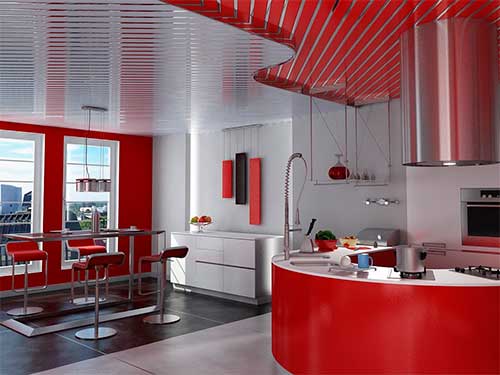
- not afraid of moisture and detergents;
- wear-resistant (can be washed often);
- resistant to temperature extremes;
- resistant to fire;
- environmentally friendly;
- does not lose its attractive appearance over time.
Metal paneling is the most durable option. Its installation requires fixing the crate and reduces the height of the ceilings. In the gap between the ceiling and the panels, you can mount the wiring, embed fixtures in the panels.
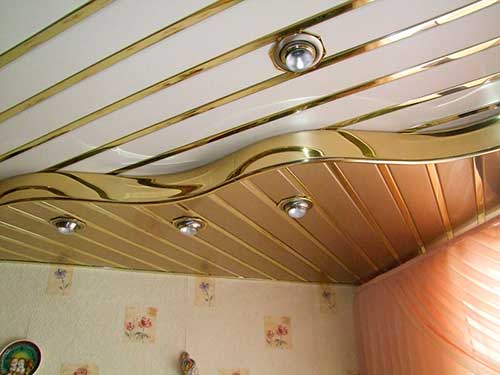
When flooded from above, the finish of the metal panels will let water through, this will not affect the appearance of the ceiling in any way.
Tension structures
A fabric or film web successfully hides defects in the ceiling plate and communications, retains an attractive appearance for many years, and is quite easy to clean. The film ceiling can be re-mounted after forced dismantling.
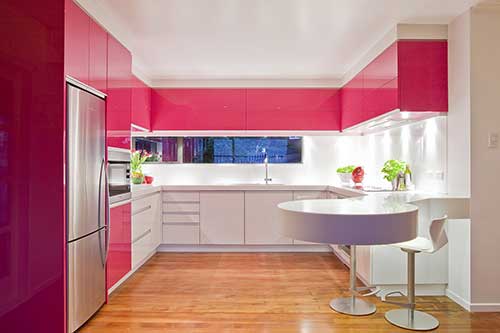
The disadvantages include:
- decrease in ceiling height by approximately 10 cm;
- the need to replace the entire canvas in case of local damage;
- for installation, specialists with special equipment and tools should be involved;
- relatively high cost;
- the fabric web is not subject to re-installation.

When flooded from above:
- the fabric ceiling will partially let water through;
- the film canvas will completely retain water, ensuring the safety of your property (to remove the water, you will need to call specialists).
Conclusion. After evaluating the pros and cons of each option, comparing the complexity of installation and the amount of financial costs, you can choose the best type of finish for the ceiling in your kitchen.
Video on the topic "which ceiling is better to do in the kitchen":

